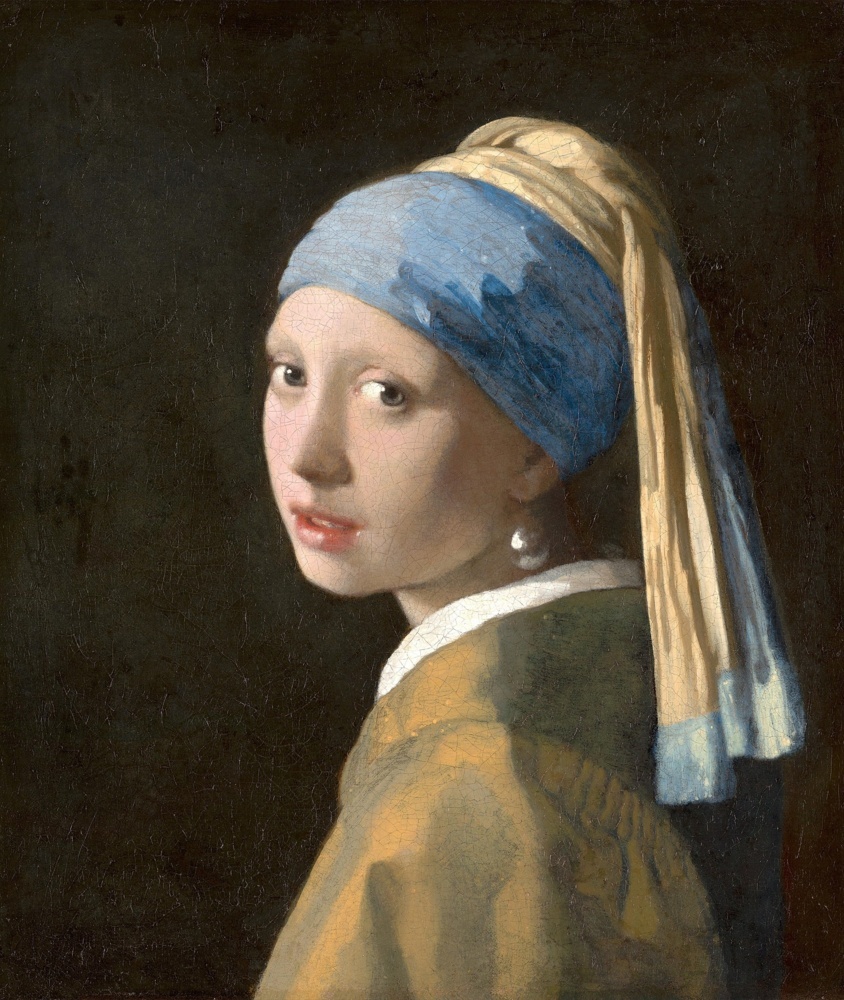 Girl with a Pearl Earring, Johannes Vermeer, Oil on canvas, 1665, 44.5 cm × 39 cm
Girl with a Pearl Earring, Johannes Vermeer, Oil on canvas, 1665, 44.5 cm × 39 cm
The Girl with a Pearl Earring is an oil on canvas painting produced around 1665 by Johannes Vermeer, a Dutch painter. This bust portrait of an anonymous young woman wearing a pearl in her ear and a turban on her head is often called the "Mona Lisa of the North", because of its composition and its subject close to the work of Leonardo da Vinci. vinci. Although the painting shows an influence from Italian portraiture, it mainly belongs to the pictorial genre of tronies, typical of the art of the United Provinces of the mid-17th century. The Girl with a Pearl Earring is a representative example of the Golden Age of Dutch painting.
Considered one of Vermeer's masterpieces for its composition and atmosphere, the canvas had fallen into oblivion for more than two hundred years before being rediscovered by the art collector Arnoldus Andries des Tombe, who bequeathed it in 1903 to the Mauritshuis museum, in The Hague in the Netherlands. Since then, the painting is still preserved and exhibited there. In 1994 it was restored, which made it possible to better appreciate its quality and the technique used by Vermeer.
Description of the work
The Girl with a Pearl Earring is an oil painting produced on a medium-sized canvas (44.5 x 39 cm) and presented in a wooden frame carved with floral motifs. It represents a teenager or a young adult in bust, three-quarters back and three-quarters front. She wears an ultramarine blue turban topped with a yellow cloth and a pearl in her left ear. She is dressed in a heavy fabric jacket of dark ocher or brown color. A sharp light coming from the left edge of the painting illuminates the model practically from the front, producing various shadows on her back and the back of her head. The shimmering reflections of the ear pendant stand out in the shaded part.
The painting bears the signature of Johannes Vermeer, the letters I, V and M being tied on the left (the letter J was still sometimes written as I in the 17th century). The signature is painted in tones close to those of the background of the background, which makes it very inconspicuous on the canvas and practically never on the reproductions of the work.
Although the painting is undated, scholars believe it was painted around 1665. When created, the work was not given a specific title and was simply referred to as a "tronie". It was not until the second half of the 20th century that she was called the "Young Girl with a Turban", then "The Young Girl with a Pearl Earring" from the mid-1970s.
The painting is also nicknamed the "Mona Lisa of the North" because of its composition and subject close to the work of Leonardo da Vinci.
Techniques used
 Drawings of a camera obscura in L'Encyclopédie (1772)
Drawings of a camera obscura in L'Encyclopédie (1772)
It is now established that Vermeer used the camera obscura as a tool to make many of his works. This optical process allowed the image of a model to be projected onto a flat surface, where it appeared smaller and upside down. By going over the features of the projected image, the artist obtained a preparatory drawing of almost photographic precision. Several clues suggest that Vermeer used the camera obscura for The Girl with the Pearl Earring.
However, the illusion of reality in the painting is mainly based on pictorial choices. The pose of the young woman, inspired by Titian, creates a visually interesting effect of tension by diverging the position of her body and the orientation of her gaze. Vermeer accentuates this effect by emphasizing the vertical axis of rotation through the shadow that descends from the model's left temple to his torso.
The lighting and the contrast between the black background and the light complexion of the face produce a trompe-l'oeil effect. Vermeer used a palette of only ten pigments to compose a work with very fine and soft plays of light. His style is expressive and contrasts with the precise and polished style of his contemporaries. The background is dark, emphasizing the contours of the face and creating an impression of the character's isolation. Vermeer used indigo, gaude, and animal black for this dark area, but mixing the plant-derived pigments results in a translucent green. The causes of the aging of the painting are multiple and result from the successive restorations, the various retouchings, the evolution of the binder used by Vermeer and the partial discoloration of the indigo.
The choice of a dark and uniform background allows Vermeer to bring out the two dominant colors of his work: the ultramarine blue of the turban and the lemon yellow of the fabric. For the blue, Vermeer uses two solid colors corresponding to the lighted and shaded areas of the turban, with internal shades to mark the folds of the fabric. He mainly uses lapis lazuli, indigo and lead white to achieve these blue tones. As for the yellow of the fabric that surmounts the turban, it is obtained mainly from natural yellow ocher mixed with white lead.
The young woman's clothing is also modeled with various shades of yellow obtained mainly from yellow ocher and madder red. The face and complexion are rendered with a thin, flesh-colored glaze, on a transparent undermodeling, with a mixture of white lead, yellow ocher and vermilion. The lips are mainly obtained with madder red.
Finally, the pearl is a central point of light in the composition, with several reflections of different intensities coming from a direct light source, the face and the collar of the garment. It stands out against the dark background and contrasts with the clothing worn by the young woman.
Time and inspirations
The art market was very developed in the Netherlands at the time Vermeer painted The Girl with a Pearl Earring. Painting from this period was influenced by Dutch Calvinism and emphasized portraits and tronies. The tronie was a subgenre that sought to represent a model's situation rather than their actual identity. The Girl with a Pearl Earring shows an influence of Italian Caravaggism, although Vermeer never traveled to Italy. His mastery of chiaroscuro is characteristic of this tradition. Vermeer was considered an expert in Italian art, which led to him being commissioned to judge the authenticity of works loaned to great Italian masters.
The pose of the young girl who turns towards the viewer is inspired by Italian painting, notably Titian's Portrait of a Man and Raphael's Portrait of Bindo Altoviti. Moreover, the influence of Leonardo da Vinci's Mona Lisa is perceptible in the choice to represent a light young girl on a dark background to accentuate the contrast and the effect of presence, as well as in the sfumato technique used to blur the outlines. The rare turban motif is in line with other contemporary works by Vermeer, such as The Young Man in a Turban by Michael Sweerts.
Who was the model?
The model for The Girl with a Pearl Earring is unknown. Maria, Vermeer's eldest daughter, is often considered the most likely role model. Some researchers also believe they find the same model in other works by the painter. It is possible that Vermeer used one of his daughters as a model, which was common at the time. The idea that the model would be a servant of the house is considered unlikely. Questions about the identity of the model are considered irrelevant by some art historians, because it is above all a tronie, representing a physiognomy rather than a specific person.
7 incongruous things about the work
- The original title of the work is "The Girl with a Turban", but it was changed to "The Girl with a Pearl Earring" when Tracy Chevalier's novel was published.
- The pearl worn by the girl is actually not a real pearl, but rather a ball of glass painted in gray-blue.
- The turban the girl is wearing is not a typical Dutch hairstyle of the time, but rather a reference to oriental fashion.
- The girl's gaze is so piercing that she almost seems to follow the viewer wherever they go in the room.
- The painter Vermeer was known for using expensive and rare pigments in his works, which underlines the importance he placed on this piece.
- The light that illuminates the girl's face appears to come from a window to the left of the work, but there are no visible windows in the painting.
- The background color of the work has changed over time, changing from a dark green to a light gray.
Influences of Vermeer's Girl with a Pearl Earring in Contemporary Culture
Vermeer's work, The Girl with a Pearl Earring, has had a considerable influence on contemporary culture:
The film adaptation: The novel by Tracy Chevalier, inspired by the work of Vermeer, was adapted to the cinema in 2003 under the title "The girl with the pearl", directed by Peter Webber.
The song: American singer Katy Perry released the song "Pearl" in 2010, which refers to Vermeer's work.
Advertising: In 2014, the Dutch jewelry brand Van Amstel Diamonds used the image of the girl with a pearl earring for its advertising campaign.
Fashion: The dress worn by the young girl has inspired several fashion designers, including couturier Christian Dior in 2013.
Children's literature: Vermeer's work is also present in children's literature, notably in the album "The secret of the young girl in blue" by Alain Surget and Michel Gay.
Video games: The girl with the pearl is also present in some video games, such as Assassin's Creed II or Final Fantasy XIV.
The comic strip: The character of the girl with the pearl is also present in the comic strip, as in the album "L'Art du crime" by Nicolas Gaudemet and Olivier Berlion.
The Sculpture: A sculpture of the Girl with a Pearl Earring was created by Dutch artist Frank Rosen.
Postage stamps: Vermeer's work has also been reproduced on postage stamps, notably in France and the Netherlands.
The technology: In 2018, the Japanese company Toshiba developed an artificial intelligence that can transform a photo into a version resembling a Vermeer painting, including an option to reproduce the style of The Girl with a Pearl Earring.


 Selena Mattei
Selena Mattei